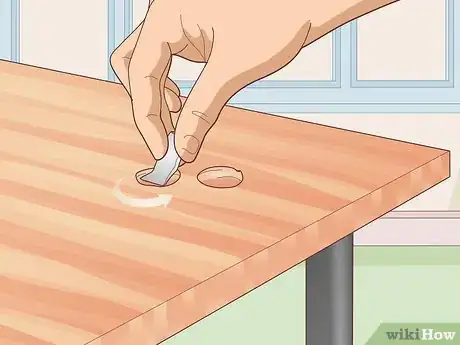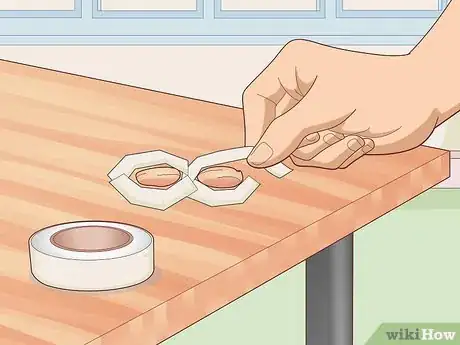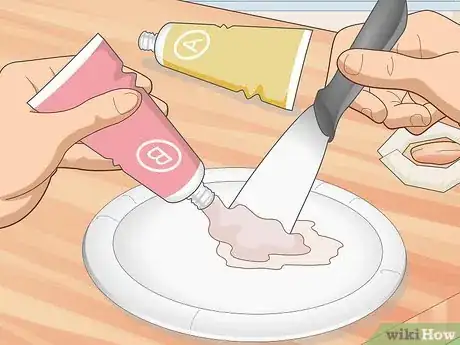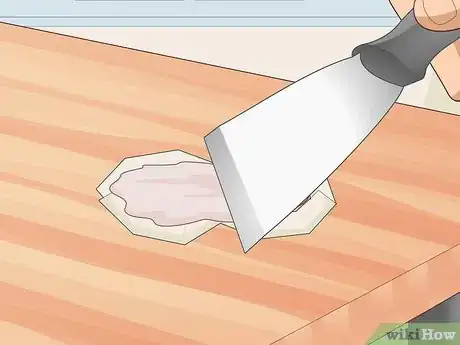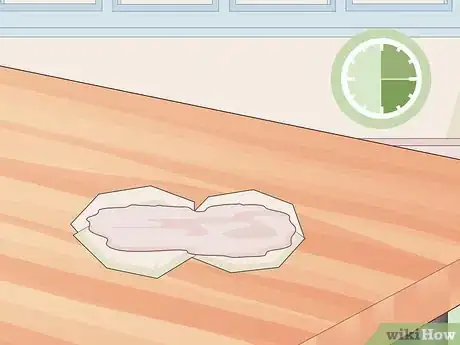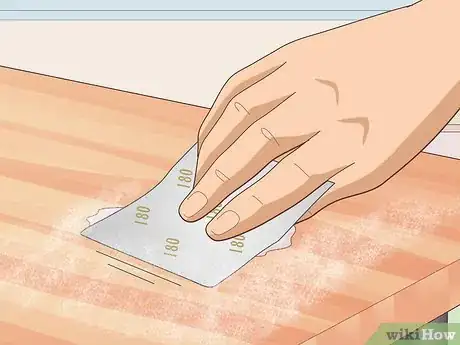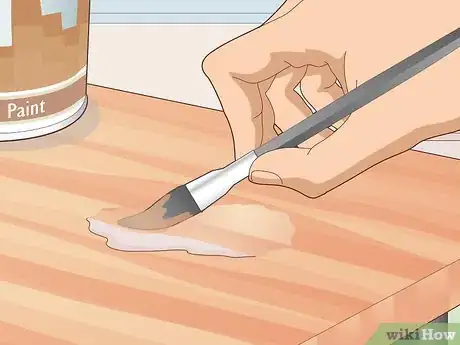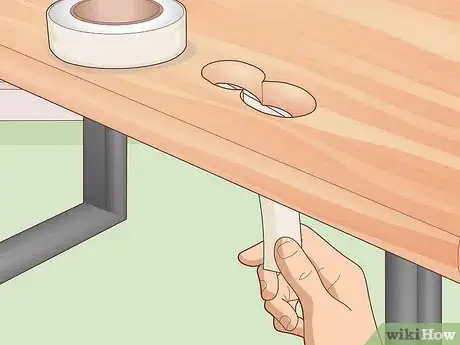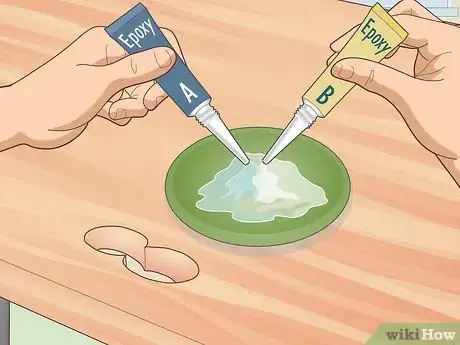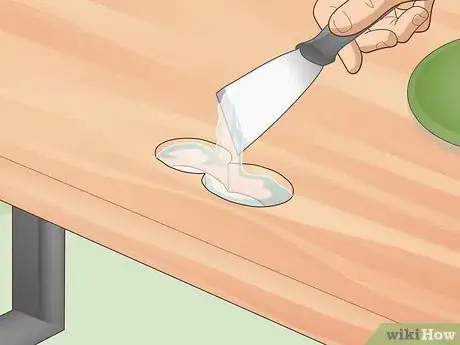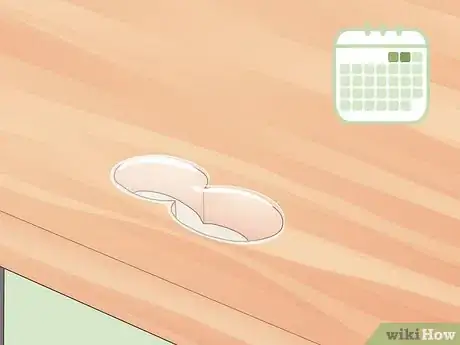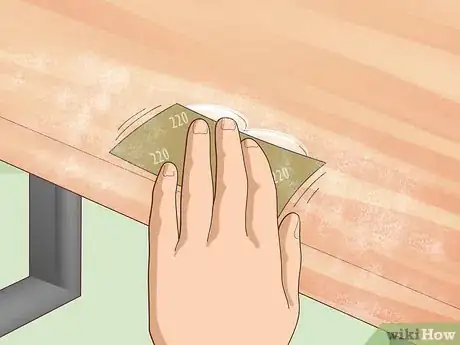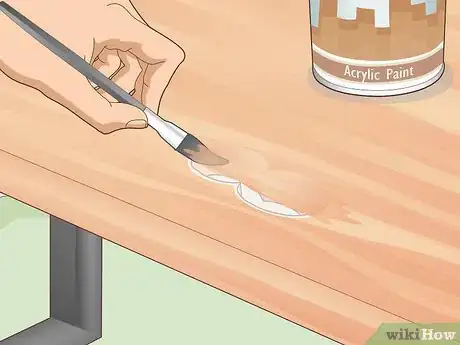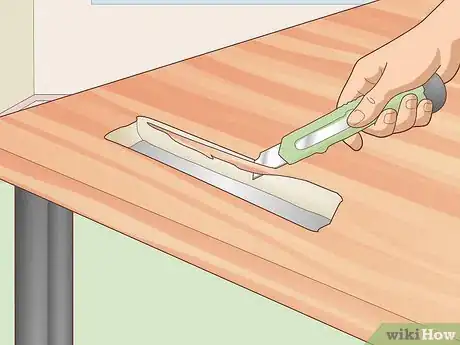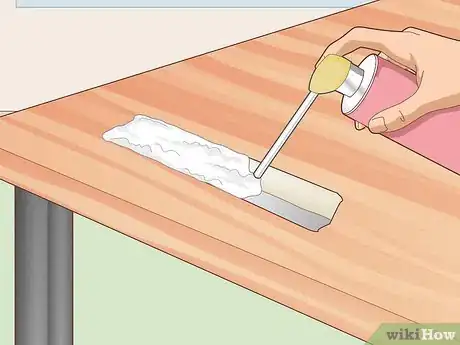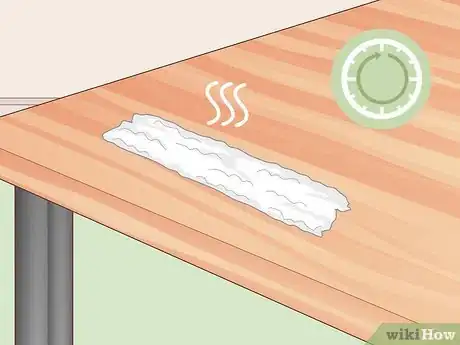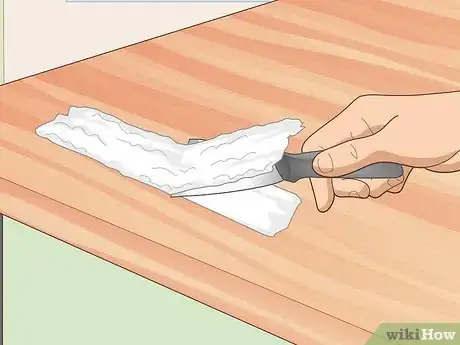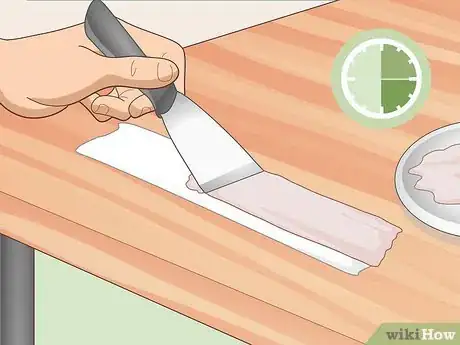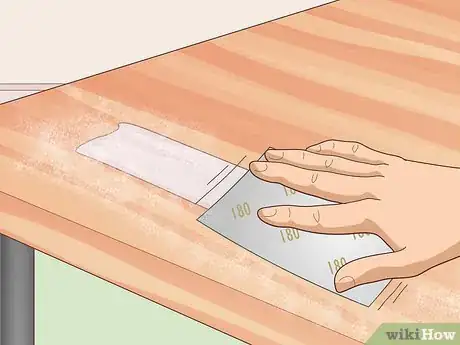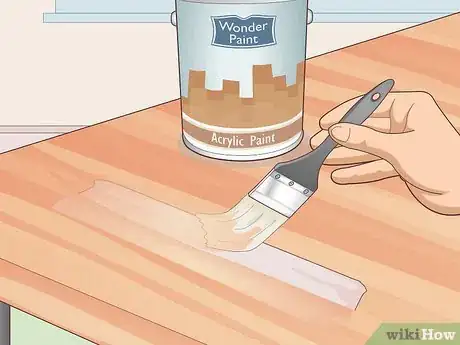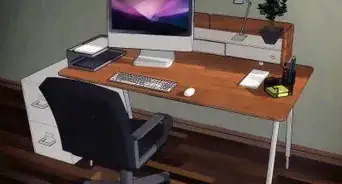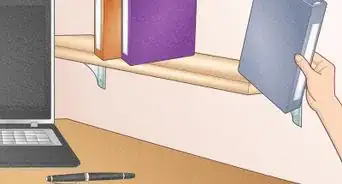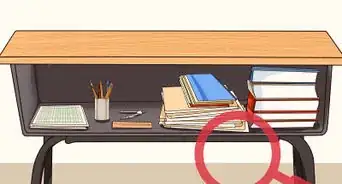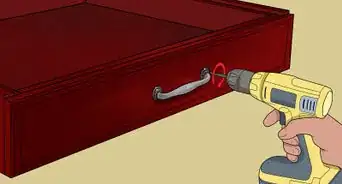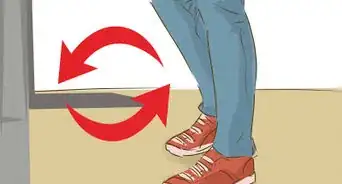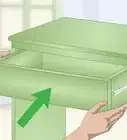This article was co-authored by wikiHow staff writer, Hunter Rising. Hunter Rising is a wikiHow Staff Writer based in Los Angeles. He has more than three years of experience writing for and working with wikiHow. Hunter holds a BFA in Entertainment Design from the University of Wisconsin - Stout and a Minor in English Writing.
There are 19 references cited in this article, which can be found at the bottom of the page.
This article has been viewed 31,052 times.
Learn more...
Accidentally drilling or punching a hole through your desk can be a real pain and make it difficult for you to get your work done. While it may seem like you need a new desk, there are many ways that you can patch the hole. You can use wood filler for shallow dents and holes smaller than a coin, but you may need to use a sturdier epoxy for bigger repairs. If your desk is hollow inside, you can also fill in the gap with expanding foam so it’s easier to patch up. When you’re finished, you’ll barely even notice that your desk was damaged!
Steps
Patching Shallow Holes with Wood Filler
-
1Smooth any rough edges around the hole with 180-grit sandpaper. If you accidentally broke your desk, the hole may have more jagged edges and won’t accept the wood filler as well. Rub around the edge of the hole with a folded piece of sandpaper to get rid of any sharp or pointed edges. Keep sanding the edges down until they have a smooth finish.[1]
- If you have trouble removing the rough edges with sandpaper, try chipping them off with a chisel. While you may need to use more wood filler, your patch will look less noticeable and blend in more.
Tip:Use wood filler on desks made of solid wood and MDF.
-
2Tape around the hole with masking tape. Rip off pieces of masking tape and place them as close to the hole’s edges as you can. Use small pieces of tape so you can work around and curves easier without any waste. Just be careful that the tape doesn’t fold over the edge, or else you won’t be able to peel it off once the filler dries.[2]Advertisement
-
3Mix the wood filler and hardener with a putty knife. Buy a package of 2-part wood filler that comes with a bottle of hardener. Follow the mixing directions on the wood filler’s package so you know how much of each product you need to mix. Put the wood filler onto a paper plate or into a disposable cup before adding your hardener. Stir them both together until they’re thoroughly combined and have a uniform color.[3]
- You can buy wood filler from your local hardware store. Opt for one that’s stainable so you can apply finish to it later on.
Warning: Once you mix the wood filler with the hardener, it will begin to set, so work with it as soon as you can so it doesn’t become difficult to apply.
-
4Press the wood filler into the hole using your knife. Scoop up some of your wood filler onto your putty knife and press it into the hole in your desk. Try to push the wood filler as far in as you can so it fills in the space completely. Keep adding wood filler until it’s level with the wood around it. Hold the putty knife at a 45-degree angle and pull it across the hole one more time to smooth it out and remove excess.[4]
- It’s okay to leave about 1⁄8–1⁄4 inch (0.32–0.64 cm) of the wood filler above level since it will sink deeper into the wood as it sets.
-
5Let the wood filler dry for about 15–30 minutes. Leave the wood filler alone for about 15 minutes before checking on it again. Tap on the wood filler to see if it feels tacky, and allow it to dry for another 5–10 minutes if it does. Otherwise, you can continue working on your patch.[5]
- Your wood filler may take longer to dry depending on the depth and size of the hole, so always check it before moving on.
-
6Sand the wood filler down with your sandpaper. Take your 180-grit sandpaper and run it over the wood filler. Apply a moderate amount of pressure to smooth out any raised edges. Keep sanding down the patch until it’s perfectly level with the wood around it.[6]
- Use a scrap wooden block to apply more pressure while sanding if you have a difficult time smoothing out the filler.
-
7Stain or paint the wood filler to match the rest of your desk. Choose a paint or stain that’s the same color as your desk so the patch doesn’t look out of place. If you’re staining the filler, apply it with a paintbrush before wiping off any excess with a shop cloth. If you’re painting, apply a layer of primer and let it dry first. Then use a paintbrush to paint the wood filler in the direction of the grain.[7]
- You may also leave the patch unfinished if you want to give your desk a unique look or accent.
- You can either match the wood filler patch to your desk color or refinish your desk completely to update its look!
Using an Epoxy Resin on Large Holes
-
1Tape off the bottom of the hole if it goes through the wood. Check the other side of the wood to see if the hole broke through. If it did, rip off pieces of masking tape and stretch them across the hole. Overlap each piece of tape by at least 1⁄2 inch (1.3 cm) so the epoxy doesn’t leak out. Press the tape tightly against your desk so it doesn’t come undone while you make repairs.[8]
- If the hole is on the edge of your desk, place your tape along the sides so it’s perpendicular to the surface with the hole.
-
2Mix your epoxy and the hardener in a disposable container. Your package of epoxy will come in 2 separate containers of base and hardener. Use an old plastic food container or a paper plate since it can be difficult to remove epoxy once it’s dry. Scoop out the epoxy base with a putty knife and put it in your container. Follow the mixing directions so you know how much hardener to add. Stir the epoxy mixture until it has a uniform color.[9]
- You can buy 2-part epoxy from your local hardware store.
- Epoxy is stronger than wood filler, and it works best on solid wood, MDF, and particleboard.
Tip: Only mix your epoxy right before you’re going to apply it so it doesn’t solidify or become difficult to work with. Check the epoxy’s package to see how long it takes to set, since it may vary from 5 minutes to a few hours.
-
3Fill the hole in your desk with the epoxy. Scoop the epoxy with your putty knife and push it into the hole as far down as you can. Shape the epoxy while it’s malleable so it fills in the entire hole and keep pressing it down to pack it in. Smooth out the epoxy with the edge of your putty knife to make it level with the wood so it’s easier to sand and work with later on.[10]
- If you had to tape the bottom of the hole, check that the pieces haven’t come loose to ensure the epoxy doesn’t drip or fall out.
-
4Allow the epoxy to cure for 1–2 days. While epoxy may harden to the touch within a few minutes or hours, it can take longer for it to set internally. Wait at least 1–2 days for the epoxy to harden and dry completely before working on it, or else you may damage your patch.[11]
Warning: Epoxy can let out harmful fumes while it dries, so keep the room well-ventilated by opening windows or turning on a fan.
-
5Smooth the epoxy with 180- or 220-grit sandpaper. Apply firm pressure around the edges of the dried epoxy to remove any raised bumps. Wipe the dust away with a damp shop cloth frequently so you can see what you’re working on. Keep sanding your patch until it’s perfectly level with the rest of the wood.[12]
- You can also use an electric sander if you have trouble smoothing the epoxy by hand.
-
6Prime and paint the epoxy so it blends in with your desk. Epoxy doesn’t accept stain, so you’ll have to use acrylic paint if you want it to match the color of your desk. Apply a thin layer of acrylic primer to the epoxy. Allow the primer to dry for about 1 day before painting over it with the matching color. Feather the paint out onto the wood surrounding your patch to help it blend in and look less noticeable.[13]
Filling Hollow-Core Desks with Expanding Foam
-
1Trim off any rough edges around the hole with a utility knife. Place the blade against the edge of the hole. Cut into the wood at a slight angle to remove the small jagged pieces so it’s easier to patch your desk. Work your way around the entire hole to give it a smooth, beveled edge.[14]
- Use caution when working with your utility knife so you don’t cut yourself if the blade slips.
-
2Spray expandable foam insulation into the hole so it fills in. Expandable foam insulation grows to fill the space it’s filling so it provides an even work surface for your patch. Put the nozzle into the hole around the edge of the hole and press down on the button. Move the nozzle around so you don’t apply too much foam in one place. Pull the nozzle out once the hole looks half full since the foam will continue to expand. As the foam expands to the edge of the hole, press it in firmly with a putty knife.[15]
- You can buy a can of expandable foam from your local hardware store.
-
3Allow the foam to set for 12 hours or until it’s dry. Your spray foam treatment will continue growing and start hardening as it sets. Leave the foam alone for at least 12 hours so it has a chance to harden completely. Test the foam with your finger, and allow it to dry longer if it still feels tacky. Try checking it again in 30 minutes to see if it’s hardened.[16]
-
4Trim the excess foam off with a putty knife. Hold your putty knife so it’s pressed flush against the wood surrounding your patch. Push the blade of the knife through the foam with gentle back-and-forth movements to cut through the foam. Throw the excess piece of foam away with your regular trash so the top of the foam looks level with the wood.[17]
- If you have trouble using a putty knife, you can also use a utility knife to cut through the foam.
-
5Apply wood filler on top of the foam and let it set for 15–30 minutes. Your wood filler will come with a base bottle and a hardener bottle. Mix the wood filler and hardener together on a paper plate with your putty knife until they’re thoroughly combined. Scoop the filler onto your knife and push it into the hole so it covers the foam. Spread the filler smoothly on top of the foam and scoop off any excess around the edges. Leave the wood filler for about 30 minutes so it can harden.[18]
- You can buy wood filler from your local hardware store.
Variation: If you don’t have wood filler, you can create your own by mixing equal parts sawdust and wood glue until it forms a thick paste.[19]
-
6Sand the surface smooth with 180-grit sandpaper. Apply firm pressure with your sandpaper to smooth out any raised edges or bumps in the wood filler. Wipe away any dust from your work area so you can see what you’re doing well. Keep sanding your patch until it’s smooth with the surrounding wood.[20]
- If the surface still feels rough, try following up 220-grit sandpaper.
-
7Paint or stain your patch the same color as your desk. If you’re painting, prime the patch first so the paint applies evenly and doesn’t fade. Let it dry completely before applying a coat of acrylic paint. If you plan on staining, pick any type of wood stain and apply a thin coat with your paintbrush. Wipe off the excess with a shop cloth and let the stain dry before using your desk again. Try to match the patch to the surface to the color of your desk rather than painting or staining the whole thing.[21]
Warnings
- Use caution when using a utility knife or razor blade so you don’t accidentally cut yourself.⧼thumbs_response⧽
- Uncured epoxy can create harmful fumes as it dries, so keep your work area well-ventilated.[22]⧼thumbs_response⧽
Things You’ll Need
Patching Shallow Holes with Wood Filler
- 180-grit sandpaper
- Masking tape
- Wood filler
- Putty knife
- Wood stain or paint
- Paintbrush
Using an Epoxy Resin on Large Holes
- Masking tape
- 2-part epoxy resin
- Stir stick
- Paper plate or disposable container
- 180- or 220-grit sandpaper
- Paint or wood stain
- Paintbrush
Filling Hollow-Core Desks with Expanding Foam
- Utility knife
- Expandable foam
- Putty knife
- Wood filler
- 180-grit sandpaper
- Paint
- Paintbrush
References
- ↑ https://www.bobvila.com/articles/how-to-use-wood-filler/
- ↑ https://youtu.be/UgpL9nurFT4?t=100
- ↑ https://www.ronhazelton.com/projects/how_to_repair_broken_corners_on_furniture
- ↑ https://www.bobvila.com/articles/how-to-use-wood-filler/
- ↑ https://www.bobvila.com/articles/how-to-use-wood-filler/
- ↑ https://youtu.be/UgpL9nurFT4?t=344
- ↑ https://www.bobvila.com/articles/how-to-use-wood-filler/
- ↑ https://youtu.be/m8Vck1QKMfA?t=94
- ↑ https://youtu.be/3l5q0xaQEf8?t=132
- ↑ https://youtu.be/E_d9hK20C94?t=199
- ↑ https://youtu.be/m8Vck1QKMfA?t=407
- ↑ https://youtu.be/m8Vck1QKMfA?t=554
- ↑ https://youtu.be/m8Vck1QKMfA?t=574
- ↑ https://youtu.be/4K233OoNfKk?t=13
- ↑ https://youtu.be/Xit4fsIhkXg?t=112
- ↑ https://youtu.be/e-nhZ63Qy-0?t=110
- ↑ https://youtu.be/e-nhZ63Qy-0?t=117
- ↑ https://youtu.be/Xit4fsIhkXg?t=177
- ↑ https://www.ronhazelton.com/tips/how_to_make_wood_filler_out_of_dust_and_glue
- ↑ https://youtu.be/4K233OoNfKk?t=75
- ↑ https://youtu.be/4K233OoNfKk?t=81
- ↑ https://medlineplus.gov/ency/article/002735.htm
